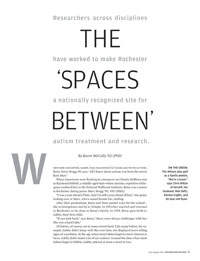Features
 ON THE GREEN: The Hiltons play golf as a family weekly. “We’re a team,” says Chris Hilton of herself, her husband, Rob (left), Peyton (right), and 10-year-old Ryan. (Photo: Adam Fenster)
ON THE GREEN: The Hiltons play golf as a family weekly. “We’re a team,” says Chris Hilton of herself, her husband, Rob (left), Peyton (right), and 10-year-old Ryan. (Photo: Adam Fenster)When her daughter, Gabby, was diagnosed 12 years ago with autism, Betsy Davis Brugg ’89 says, “All I knew about autism was from the movie Rain Man.”
When Americans were flocking to cinemas to see Dustin Hoffman star as Raymond Babbitt, a middle-aged man whose anxious, repetitive soliloquies confined him to the fictional Walbrook Institute, Betsy was a senior at Rochester dating junior Marc Brugg ’90, ’95S (MBA).
“I was a year ahead of him. And I’m still a year ahead of him,” she quips, looking over at Marc, who’s seated beside her, smiling.
After their graduations, Betsy and Marc parted ways for law school—she to Georgetown and he to Temple. In 1993 they married and returned to Rochester to be close to Betsy’s family. In 1998, Betsy gave birth to Gabby, their first child.
“If you look back,” says Betsy, “there were always challenges with her. She was a hard baby.”
All babies, of course, are to some extent hard. Like many babies, for example, Gabby didn’t sleep well. But over time, she displayed more telling signs of a problem. At the age when most babies begin to show interest in faces, Gabby didn’t make a lot of eye contact. Around the time when most babies begin to babble, Gabby uttered at most a word or two.
And whereas other babies cried, Gabby screamed. “She used to cry and scream any time we went to social gatherings. We’d go to somebody’s house for a party, and I would spend the evening in the kitchen or in the back bedroom with a screaming child,” Betsy says. “We learned she had sensitivity to noise.”
“People would say, ‘Oh, she’ll grow out of it,’” says Marc. “But we were concerned.” The Bruggs took Gabby to the Andrew J. Kirch Developmental Services Center at the University’s Golisano Children’s Hospital, where she was diagnosed with autism at age 17 months.
Like the Bruggs, Rob ’93S (MBA) and Christina (Chris) Walker Hilton ’93S (MBA) grew concerned about their firstborn child early on. At age 7 months, their son, Peyton, began making unusual and increasingly repetitive gestures and movements. “I thought, ‘Something’s wrong,’” Chris says. “But people would say to me, ‘You’re a first-time mother. Babies do strange things.’”
Peyton, too, would be diagnosed with autism at the Kirch Center, though his route to that diagnosis would prove more complicated than Gabby’s. Now 14, Peyton was diagnosed first with epilepsy—as up to a quarter of children with autism are. At 19 months, he underwent a partial hemispherectomy at the University’s Strong Memorial Hospital.
“The operation stopped his seizures, but we knew he was going to have developmental issues,” Chris says. At their pediatrician’s recommendation, the Hiltons took Peyton to the Kirch Center, where he was diagnosed with autism at age 2.
Autism is a complex disorder, but symptoms are clustered in three areas in the most recent edition of the Diagnostic and Statistical Manual of Mental Disorders: impaired social interaction, as displayed through eye contact, facial expressions, or appropriate body language; impaired oral communication, which can mean either the failure to speak or the ability to speak, but not to hold a conversation; and an insistence on repetitive behaviors and restricted routines. These symptoms can range in severity, and the intellectual abilities of some people with autism may be average or higher, while others may have significant disabilities. For those reasons, in clinical settings at least, autism is often referred to as Autism Spectrum Disorder, or ASD.
One misconception about people with autism that remains frustratingly pervasive, say the Bruggs, is the idea that people with autism are not interested in making connections with others. That doesn’t describe Gabby, who at 13 is a teenager deeply attached to her parents and to her younger sister, Samantha. She likes to snuggle. And she’s kind—someone who will approach a child who is crying to ask if he’s OK.
What’s missing is not the desire for connection, says Betsy, but the understanding of reciprocity. To describe Gabby’s struggle, Betsy uses the analogy of “the spaces between.” The spaces between, say, marbles in a cup.
“I always say, ‘Every time you teach her something, you put the marble in the cup.’ But it’s the little spaces between the marbles that’s missing. You can teach her this rule, that rule, and the next rule,” says Betsy, slapping her hand on the wooden table. “But to connect the dots? To understand the gray areas? That’s not something that’s easy to teach.”
The percentage of children who are diagnosed with autism has been increasing at a steady rate for at least the past two decades. The Centers for Disease Control and Prevention, or CDC, has been keeping statistics on the rate of diagnosis among eight-year-olds since 2000. In that year, 1 in 150 children had received an autism diagnosis by age eight. In 2006, it was 1 in 110. And this past March, the center released a report, using data from 2008, showing the prevalence had risen to 1 in 88. For boys, who are nearly five times as likely to be diagnosed with autism as girls are, the figure was 1 in 54.
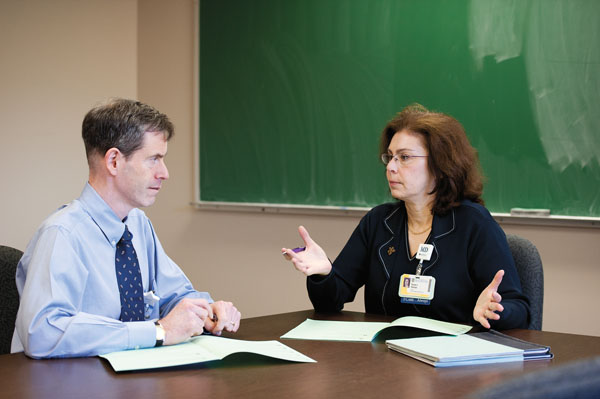 COINVESTIGATORS: Smith (left) and Hyman have helped the Medical Center’s Division of Neurodevelopmental and Behavioral Pediatrics become a national leader in autism treatment and research. (Photo: Adam Fenster)
COINVESTIGATORS: Smith (left) and Hyman have helped the Medical Center’s Division of Neurodevelopmental and Behavioral Pediatrics become a national leader in autism treatment and research. (Photo: Adam Fenster)On the evening of the day of the study’s release, CDC director Thomas Frieden was joined by Susan Hyman, chief of the division of neurodevelopmental and behavioral pediatrics at the Medical Center, on the PBS NewsHour to shed light on the findings.
A nationally recognized clinician in the field of developmental disabilities, Hyman chairs the autism subcommittee of the American Academy of Pediatrics. Although many researchers and clinicians, including Hyman, don’t rule out the possibility that autism is becoming more common, she believes the increasing rates of autism are mostly due to better recognition of the condition.
“We’re better because we’re looking. We’re better because we have more tools, and we’re better because parents and teachers are more informed about identifying concerning symptoms earlier,” she said on the program.
In the Golisano Children’s Hospital’s neurodevelopmental and behavioral pediatrics division, where she’s been since 1995, Hyman oversees a staff of more than 80 health care providers, researchers, and trainers. In the division’s Kirch Center, clinicians diagnose and treat children with many developmental disabilities in addition to autism. But of the approximately 3,000 patients seen in the Kirch Center per year, the largest single group—about 1,200—is children with autism, making the center the state’s largest provider of autism diagnoses and treatment outside of New York City.
Until recently, treatment for autism has been a mix of judgment calls and trial-and-error approaches that left many parents feeling rudderless. Chris Hilton recalls how, following Peyton’s epilepsy diagnosis, she and Rob “went through a year of pretty much black and white decisions. When you’re dealing with a more well known ailment, there’s a protocol.” But when Peyton was diagnosed with autism, she says, “there were just tons of different ways you could go and people to see. It was overwhelming.”
Gradually, researchers and clinicians are coalescing around an evidence-based standard of care for the condition. In 2008, Rochester received funding from the nonprofit Autism Speaks and the Department of Health and Human Services to become part of the Autism Treatment Network, a group of 17 medical centers in the United States and Canada working together to develop that standard of care.
Their goal is to develop a model of treatment that’s uniform, evidence-based, and reflective of the overall physical health of patients, and not just their neurology. “Autism isn’t one disorder,” says Hyman. “It turns out that people with autism often have other medical problems that may be related to the underlying biology.” About a quarter of patients, for example, suffer from seizures. Gastrointestinal problems are also common, as are sleep disorders. The network’s ultimate goal, Hyman says, is to leverage the resources of large medical centers such as Rochester’s so that “primary care doctors who are practicing away from academic centers know what they need to do to provide the optimal care.”
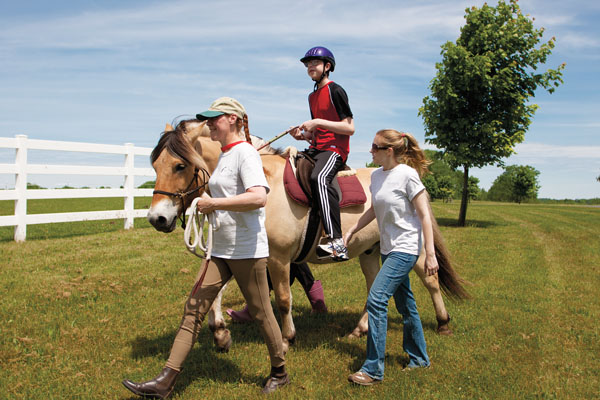 BUSY LIVES: Both the Brugg and the Hilton families emphasize keeping their children active, including therapeutic horse rides
for Peyton Hilton (above); Gabby and Betsy Brugg (below) play in the back yard of their home. (Photo: Adam Fenster)
BUSY LIVES: Both the Brugg and the Hilton families emphasize keeping their children active, including therapeutic horse rides
for Peyton Hilton (above); Gabby and Betsy Brugg (below) play in the back yard of their home. (Photo: Adam Fenster)The network includes families in the decision-making process through a family advisory committee of which Chris Hilton is a member. Following Peyton’s autism diagnosis, Hilton quit her job as a controller at Xerox to take care of Peyton and his younger brother, Ryan, and to devote herself to patient advocacy. She’s a founder of the 1,000-plus member Upstate New York Families for Effective Autism Treatment, or UNYFEAT—an organization in which she, Betsy Brugg, and Hyman are all board members—that offers programs to people with autism and their families, to improve their quality of life together. She knows from her own experience and that of many other parents what patients and their families go through and the kinds of questions and dilemmas that arise. And as Hyman says, “These are people. We don’t talk for them. We talk with them.”
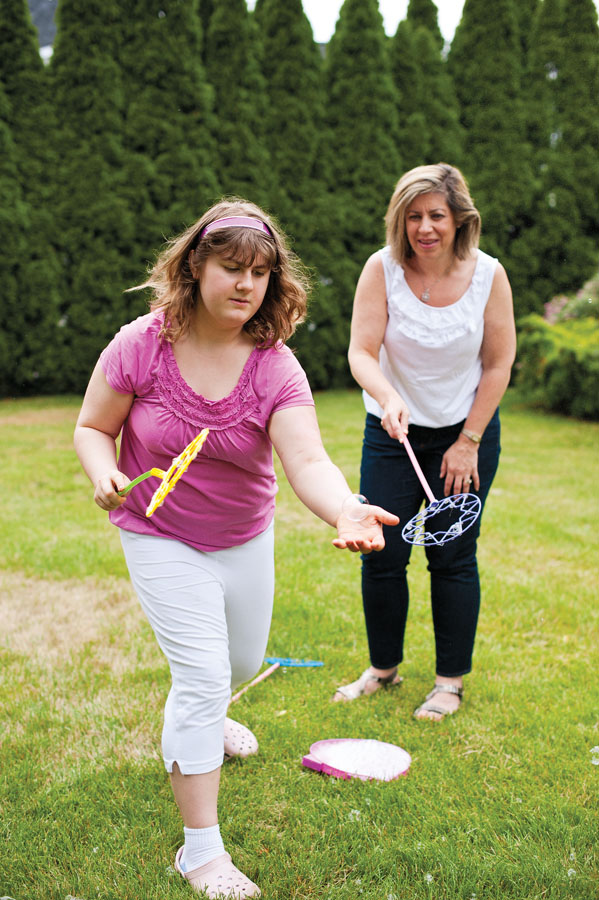 (Photo: Adam Fenster)
(Photo: Adam Fenster)At the Medical Center, Hyman codirects Rochester’s Autism Treatment Network site with Tristram Smith, an associate professor of pediatrics and a psychologist. There are few people more recognized in the field of autism treatment than Smith, whom Hyman describes as “unassuming.”
“Many people around here don’t realize this,” says Hyman, “but if there were rock stars in autism research, Tristram Smith would be a rock star.”
Smith began his career as a graduate student of the late Ivar Lovaas, a psychologist at the University of California at Los Angeles who’s a household name among a sizeable sector of the autism community. In the mid-1980s, Smith was working with Lovaas on what became a landmark study on autism treatment. The study suggested that intensive behavioral therapy, up to 40 hours a week, could result in dramatic improvements in communication and functional skills among some of the youngest children with autism—those under 4. “There were earlier studies suggesting that one could teach specific skills to individuals with autism,” says Smith. “But this was the first to show that one could alter the course of the disorder.”
Lovaas was claiming dramatic results, and not everyone was convinced. But Smith, who has conducted many follow-up studies and kept a close watch on the many replication attempts conducted around the globe since 1987, says, “there have been some improvements in regard to these studies. I think we’ve shown that that finding is for real.”
Based on the study, Smith helped develop a model of the so-called Early Intensive Behavioral Intervention, or EIBI, that would be widely accessible. Ann Wagner, chief of the Autism Interventions Research Program at the National Institutes of Health, calls that work “critical.”
“He and his colleagues demonstrated that EIBI, which had previously been evaluated in a specialty clinic setting, could be effectively implemented in public school special education classrooms,” she says. And because EIBI has become the most widely recommended treatment for autism, “this is critical to the autism community.”
From his small office in Helen Wood Hall, Smith describes a typical regimen matter-of-factly, outlining each stage. “The child needs to understand that we’re going to ask him to do things, and that if he does them, he’s going to get rewarded for that,” he says of the first step. The therapist might ask the child to place a block in a bucket, for example. The child knows how to do that, Smith points out, but “what he doesn’t know is how to interact with the teacher and deal with an instructional situation.”
From there, the therapist will move into teaching new skills. “A key area at that point is imitation,” Smith says, which lays the foundation for learning a whole range of new skills. Once the child learns to imitate, she moves onto various levels of communication, with the ultimate goal of teaching the child to interact with another child.
There are many ways to perform behavioral therapies for kids with autism, Smith says, but the key is “we’re very systematic in trying to break down skills, and reinforce every little success. By working on a whole bunch of different skills in that way, we help the kids catch up to other kids by the time they’re ready for school.”
The University has extended its work with schools to include children of all ages. The division of neurodevelopmental and behavioral pediatrics has fostered close ties with local school districts, including the Rochester City School District, through a community consultation program. The relationship is reciprocal. Program staff train educators who teach children with autism in public schools, and they receive feedback from the districts about district priorities, in light of resources that are often limited.
The consultation program has also played a key role in placing the University on the forefront of autism research. Through the relationships the program’s directors have established with schools, Smith and Hyman have been able to recruit many local children with autism to participate in clinical studies. That participation is critical because, as Smith points out, in the nation as a whole, “nearly 90 percent of children with cancer are enrolled in clinical trials, contrasted with only 5 percent of children with autism.” That disparity is a major reason, says Smith, why researchers still know far less about autism than many other chronic conditions.
Smith came to Rochester from Washington State University in 2000. By that time, Rochester was already among a small number of sites the National Institutes of Health (NIH) had designated as a center for autism research. In 1997, the University had become one of 10 sites for the NIH’s Collaborative Programs of Excellence in Autism initiative to support research into the causes of autism.
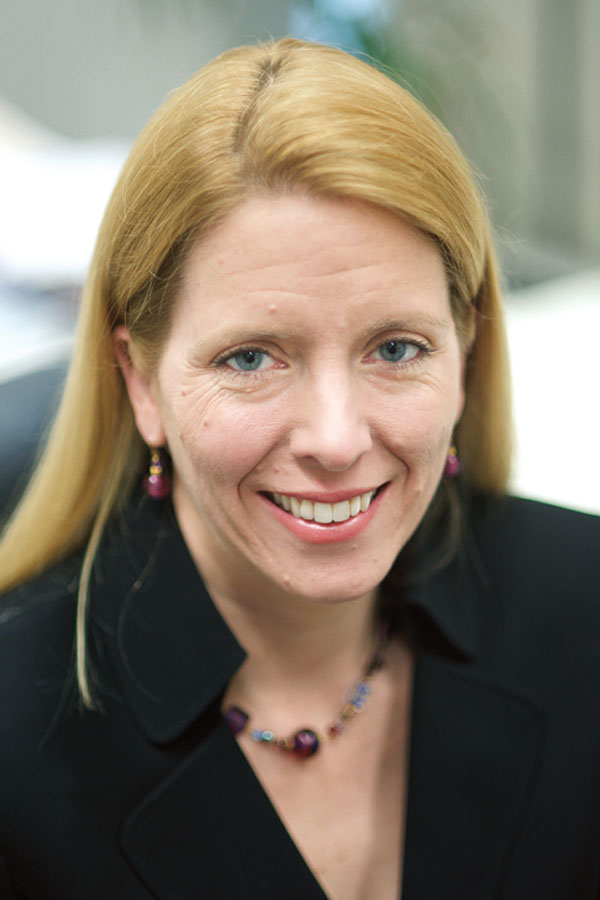 RESEARCHERS: Bennetto (left), a psychologist, and Rodier, an embryologist, formed one of Rochester’s many crossdisciplinary collaborations to study autism’s origins and potential treatments. (Photo: University Communications)
RESEARCHERS: Bennetto (left), a psychologist, and Rodier, an embryologist, formed one of Rochester’s many crossdisciplinary collaborations to study autism’s origins and potential treatments. (Photo: University Communications)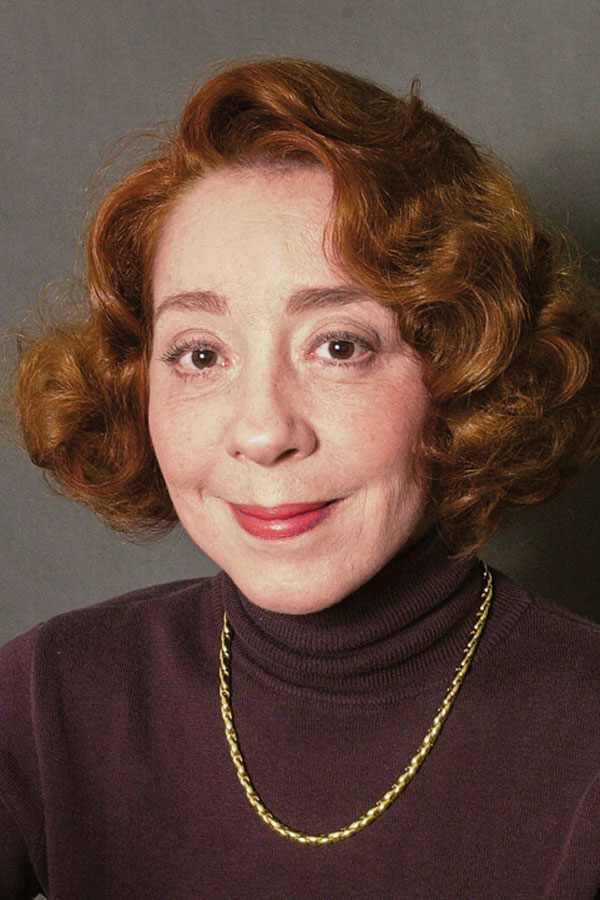 (Photo: University Communications)
(Photo: University Communications)The person most responsible for that designation was the late Patricia Rodier, an embryologist in the Department of Obstetrics and Gynecology whose research proved pathbreaking, and who died this past spring at the age of 68. A lasting impact of her work has been the collaboration it encouraged. Her research into the causes of autism, itself a multidisciplinary enterprise, led directly to the work on autism treatment that has brought together Hyman, Smith, other colleagues at the Medical Center, and faculty from the Department of Clinical and Social Sciences in Psychology in the School of Arts and Sciences.
Because autism affects higher functions such as social and communication skills, it was long assumed that it must originate in late gestation or early infancy and childhood, when significant brain development is taking place. Rodier demonstrated that autism’s roots appears to be much earlier—in fact, in the earliest period of gestation, when the central nervous system is just beginning to take shape.
Christopher Stodgell, research associate professor in the Department of Obstetrics and Gynecology, who came to Rochester in 1996, says, “At that point, in the mid-1990s, no was talking about the embryology of autism.”
But two insights that Rodier had gleaned from other studies directed her attention to early embryonic development. One study, conducted in Sweden, found a far higher than normal rate of autism among a group exposed to thalidomide—the popular morning-sickness remedy in the 1960s that had been linked directly to multiple physical birth defects—very early in gestation, as the brain stem was forming.
Later, Rodier examined a preserved brain stem of a woman who’d had autism. She discovered the brain stem lacked two components, both arising from the same part of the neural tube, which gives rise to the central nervous system. Rodier had seen brain stems like this one before—in mice, in which researchers had deliberately blocked the expression of a gene called HOXA1 to study its role in brain development.
Rodier had decided to test the hypothesis that toxins, in combination with genes, caused autism. She devised a study using rats. She exposed an experimental group of pregnant rats to valproic acid—an anticonvulsant used in treating epilepsy and long known to lead to birth defects in both humans and rodents and suspected of a role in autism—during precisely the time HOXA1 would have been forming the brain stem.
It was that study that attracted Stodgell, then just out of graduate school in pharmacology at the University of Kansas, to come to Rochester. To pursue this research through the NIH’s Collaborative Programs for Excellence in Autism, Rodier brought together experts at Rochester, Cornell, Delaware, and elsewhere.
Stodgell recalls it as a heady experience. “Through my initial training, I was working with embryologists, pediatricians, psychologists, cancer biologists, neurologists,” he says. “And all of us were asking the same question: What causes autism? But we were all coming at it from different angles.”
The rat study proved groundbreaking. And in the February 2000 issue of Scientific American magazine, Rodier wrote a feature article explaining the findings. HOXA1 was a developmental gene; that is, it controlled the development of the brain by guiding the activity of other genes. A search for gene variants of HOXA1 using DNA samples from people with autism and a control group yielded two variant genes, she explained.
But from there, the mystery grew more complicated, as it invariably does in the search for the origins of autism. Presence of the gene variant increased the likelihood of autism, but didn’t guarantee it. And many people with autism did not have the gene variant. More than one factor, and more than one gene, were clearly involved.
Stodgell followed up with a study on the interaction of valproic acid and HOXA1 gene expression, in which he found that not only did exposure to valproic acid have a significant effect on HOXA1 gene expression, but the timing of exposure, down to the hour, also played a role in how the gene behaved. It affected for example, whether HOXA1 was “turned on”—the colloquial phrase referring to when a gene expresses itself—or turned off, and if turned on, how high.
“From there, we’ve gone on to looking at other genes and that’s some of the work that’s going on now,” he says. He adds that researchers in the global effort to identify relevant genes have identified more than 250 that play a role in autism.
As researchers try to pinpoint both genetic and environmental factors, Stodgell indicates that researchers are looking at two kinds of genetic mutations: inherited mutations, which are mutations that have survived and proliferated over time; and de novo mutations, which are spontaneous mutations that aren’t inherited but show up during DNA replication. “There are some studies that have just come out that show that there’s a higher rate of de novo mutations than we thought,” Stodgell says. “And we don’t know why that is.”
An expert in neurotoxicology in addition to genetics, he suspects the reasons may be environmental. He points to a 2011 Stanford-led twin study that made a big impact in the research community by suggesting the environment inside the womb has “a much greater impact than previously thought,” he says.
In that study, researchers looked at nearly 200 sets of twins in which at least one of the twins had autism. The subjects included identical twins, who share 100 percent of their genes, and fraternal twins, who share 50 percent of their genes. Far more often than researchers expected, if one fraternal twin had autism, the other did as well.
The quest to determine which environmental factors come into play, however, is as complicated as the quest to identify relevant genes. To date, only five environmental exposures have been shown to increase risk for autism, and in each case, only when the exposure was in utero: thalidomide; valproic acid; the rubella virus; alcohol at a level high enough to induce fetal alcohol syndrome; and the anti-inflammatory misoprostol, used for a range of purposes, from preventing ulcers to inducing labor.
“A lot of the funding right now is going back into treatment and phenotyping and characterizing, and to tell you the truth, that’s not a bad thing,” Stodgell says.
Parents and schools have immediate concerns to deal with. And, he adds, “no one treatment works for everybody.”
In 2003, the NIH awarded Rochester a Studies to Advance Autism Research and Treatment grant, one of only eight such grants in the United States, making the University one of eight “STAART centers” in the nation.
Under the STAART grant, the University accelerated its work on an additional dimension of autism treatment. Stodgell notes that when researchers have studied the genetic makeup of individuals diagnosed with autism, they’ve grouped together a pretty heterogeneous population.
“Not all socialization deficits or repetitive, restrictive behaviors are the same, even though they get lumped into a number in the diagnostic algorithm,” he says.
To understand the genetic roots of autism, he says a better approach is to study subjects who share particular behaviors that are correlated with autism—behaviors such as restrictive eating habits, or sensitivity to certain textures and sounds—and to study the genetics of the particular traits.
Loisa Bennetto, associate professor of psychology and now the chair of the Department of Clinical and Social Sciences in Psychology, leads several studies on autistic behaviors from her lab on the River Campus. She and Stodgell are married, and they met at Rochester, collaborating on autism research.
She says that when she arrived at Rochester in 1998, she met Rodier. They discovered they were both conducting studies of the facial nerve.
“She was studying cranial nerve dysfunction in autism,” Bennetto says of Rodier. Rodier was focused on the facial nerve, which controls the muscles used in facial expressions, because many people with autism have abnormalities in the nerve, which develops from the brain stem very early in gestation.
“I was studying nonverbal communication in autism including gestures and facial expressions,” says Bennetto. “I started collaborating with them,” she says of Rodier, Stodgell, and others in the lab “and it turned out to be a great collaboration.”
Bennetto has led multiple studies on sensory processing, particularly the processing of taste and smell. Restrictive eating habits, as well as unusual responses to tastes and smells—either hypersensitivity or hyposensitivity—are among the most common traits of people with autism.
She works on characterizing these traits—or what’s called the phenotype of the study participants—while Stodgell studies the genotype of participants and their families, looking for gene variants that might be associated with particular traits.
Building on an earlier finding that children with autism process taste and smell differently from their typically developing peers, the two are looking at restrictive eating behaviors among children with autism and asking: To what degree are restrictive eating habits due to the patient’s processing of sensory information such as taste and smell? To what extent are they merely another instance of the patient’s general insistence on rigid, predictable routines? Do the traits run in families or are they particular to autism?
Bennetto notes that eating involves many senses. Smell contributes to our sense of taste, but so too does visual information, such as color, and tactile information, such as texture. “If children with autism have trouble integrating that information, it’s going to affect their food preferences.”
“The big question is, how do these underlying sensory difficulties drive our ideas about treatment?” she adds.
That’s a project for Smith and Hyman, who are looking to develop new treatment regimens based on the preliminary findings of Bennetto’s and Stodgell’s and other similar studies.
For Hyman, the key to progress has been collaboration— collaboration among researchers, with parents and caregivers, and with schools.
These relationships, says Hyman, “have really opened up dialogues that are not present at a lot of other places. It’s a true example of how translational research occurs.”
Hilton agrees. She says there are many issues that remain to be addressed, both in the research, and in terms of access to what the research has provided. But looking back 12 years, she also sees the progress. “We hear it all the time,” she says. “Parents feel much better prepared.”
“You don’t want that diagnosis. But at least once you get it, now you know, ‘Ok, I can move forward, rather than running in place.’ ”
